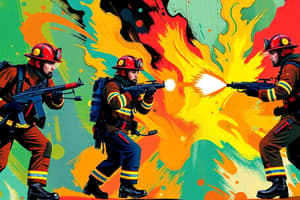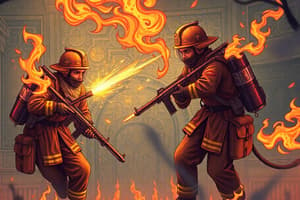Podcast
Questions and Answers
What is the primary objective of the initial attack efforts during an offensive fire strategy?
What is the primary objective of the initial attack efforts during an offensive fire strategy?
- To extinguish the fire completely before making an entry.
- To assess the structural integrity of the building.
- To support a primary search for victims. (correct)
- To ventilate the structure as quickly as possible.
What should be done to the building openings prior to entering an offensive attack?
What should be done to the building openings prior to entering an offensive attack?
- Keep the building openings closed to reduce fire ventilation. (correct)
- Seal all exits to prevent smoke from escaping.
- Open all windows to allow for ventilation.
- Break windows to assess the fire conditions.
Which tactic should be implemented before making entry into a fire-compromised structure?
Which tactic should be implemented before making entry into a fire-compromised structure?
- Reset or darken down the fire using a straight stream. (correct)
- Initiate a systematic ventilation process.
- Conduct a full inspection of the interior.
- Apply water in a fan pattern to cool the area.
What is the recommended approach for entering a structure during an offensive fire attack?
What is the recommended approach for entering a structure during an offensive fire attack?
What is the main purpose of gathering 360° of information on the fireground before starting operations?
What is the main purpose of gathering 360° of information on the fireground before starting operations?
Why is it critical to coordinate ventilation during a fire attack?
Why is it critical to coordinate ventilation during a fire attack?
Which statement correctly describes the relationship between search, rescue, and fire attack operations?
Which statement correctly describes the relationship between search, rescue, and fire attack operations?
What is meant by the term 'candle moth syndrome' in the context of firefighting?
What is meant by the term 'candle moth syndrome' in the context of firefighting?
What must command prioritize when considering fire extension?
What must command prioritize when considering fire extension?
Which of the following is NOT a side or sector of the fire that command must address?
Which of the following is NOT a side or sector of the fire that command must address?
What is essential for effectively combating concealed space fires?
What is essential for effectively combating concealed space fires?
Command must not lose sight of what basic fireground reality?
Command must not lose sight of what basic fireground reality?
What factor is critical for command to manage in developing an effective attack?
What factor is critical for command to manage in developing an effective attack?
When should ventilation be initiated during a fire attack?
When should ventilation be initiated during a fire attack?
What happens if command misjudges the time it takes to set up an attack?
What happens if command misjudges the time it takes to set up an attack?
What must command consider when allocating personnel and resources for fire extension?
What must command consider when allocating personnel and resources for fire extension?
Which statement about addressing concealed spaces during a fire is correct?
Which statement about addressing concealed spaces during a fire is correct?
What strategy should command adopt regarding property that is already lost to the fire?
What strategy should command adopt regarding property that is already lost to the fire?
What aspect of fire extension must command evaluate to effectively allocate resources?
What aspect of fire extension must command evaluate to effectively allocate resources?
Which component is essential to consider when establishing an attack plan for fire control?
Which component is essential to consider when establishing an attack plan for fire control?
What must be coordinated with ventilation efforts during a fire attack?
What must be coordinated with ventilation efforts during a fire attack?
Which of the following is a critical strategy when dealing with concealed space fires?
Which of the following is a critical strategy when dealing with concealed space fires?
What is the primary risk of failing to account for all seven sides of the fire?
What is the primary risk of failing to account for all seven sides of the fire?
Why is it necessary to project setup time during firefighting operations?
Why is it necessary to project setup time during firefighting operations?
What should command do with property that is already lost to the fire?
What should command do with property that is already lost to the fire?
What is one of the fundamental variables that command must manage during an attack operation?
What is one of the fundamental variables that command must manage during an attack operation?
What is the consequence of not getting ahead of the fire?
What is the consequence of not getting ahead of the fire?
What approach should be taken when making decisions about cutoff points?
What approach should be taken when making decisions about cutoff points?
What is the first step to be taken once size up is completed and an offensive strategy is determined?
What is the first step to be taken once size up is completed and an offensive strategy is determined?
Which action is most effective in reducing temperatures in a fire compartment before entry?
Which action is most effective in reducing temperatures in a fire compartment before entry?
What should be maintained to prevent the 'candle moth' syndrome during an offensive fire attack?
What should be maintained to prevent the 'candle moth' syndrome during an offensive fire attack?
In an offensive fire attack, where should the fire attack line be directed for optimal impact?
In an offensive fire attack, where should the fire attack line be directed for optimal impact?
What is the recommended approach regarding building openings during an offensive fire attack?
What is the recommended approach regarding building openings during an offensive fire attack?
What should be prioritized when entering the structure during a fire attack?
What should be prioritized when entering the structure during a fire attack?
What is a key consideration when evaluating a fire scene for decision-making in an offensive attack?
What is a key consideration when evaluating a fire scene for decision-making in an offensive attack?
How should firefighters apply water to the fire during an offensive strategy?
How should firefighters apply water to the fire during an offensive strategy?
Flashcards are hidden until you start studying
Study Notes
Offensive Fire Strategy Overview
- Thorough size up and life safety assessment are critical for commercial and residential fire responses.
- Determine if an offensive attack is safe before executing tactical objectives.
Guidelines for Offensive Fire Attacks
- Assume Command to centralize decision-making and coordination.
- Address the 2 in / 2 out rule for personnel safety before entry into the fire.
- Initial attack should support primary search, targeting obvious victims and managing hazards. Identify fire conditions and extent prior to operations.
- Gather a complete 360° assessment of the scene to inform strategies and identify potential victim locations.
Attack Techniques and Considerations
- Fight offensive fires aggressively with prompt and effective size up.
- Keep building openings closed when possible to limit fire ventilation until a charged hose line is ready.
- Use a straight stream aimed at the ceiling for 15-30 seconds before entry to lower temperatures and improve tenability.
- Enter at the air intake side of the flow path, keeping air at the back to minimize danger.
Coordination and Ventilation
-
Coordinate ventilation to enhance interior conditions; avoid "tunnel vision" and consider unburned areas for strategic planning.
-
Evaluate fire extension factors like:
- Rescue activities
- Firefighter risk levels
- Confinement and exposure efforts
Command Structure and Tactics
- Allocate resources based on fire spread analysis, ensuring firefighters are engaged in active fire control.
- Develop an attack plan focusing on overpowering the fire with water application from both offensive and defensive positions.
- Address all seven sides of the fire: front, rear, both sides, top, bottom, and interior for overall control.
Concealed Space Challenges
- Identify and combat concealed space fires early, as these areas can rapidly contribute to fire spread.
- Avoid hesitation to access concealed spaces; timely intervention can save structures.
- Coordinate early ventilation with internal crews to improve effectiveness during attacks.
Command Decisions for Fire Control
- Stay ahead of the fire by anticipating its movement; set up operations before it can extend further.
- Consider property losses and prioritize protecting exposed structures.
- Basic attack variables include the location and size of the attack along with necessary support functions.
Strategies for Effective Management
- Balance attack size and positioning with fire conditions, risks, and available resources to develop an effective firefighting strategy.
- Command must remain proactive to maintain control and ensure safety for all personnel involved in fire operations.
Offensive Fire Strategy Overview
- Thorough size up and life safety assessment are critical for commercial and residential fire responses.
- Determine if an offensive attack is safe before executing tactical objectives.
Guidelines for Offensive Fire Attacks
- Assume Command to centralize decision-making and coordination.
- Address the 2 in / 2 out rule for personnel safety before entry into the fire.
- Initial attack should support primary search, targeting obvious victims and managing hazards. Identify fire conditions and extent prior to operations.
- Gather a complete 360° assessment of the scene to inform strategies and identify potential victim locations.
Attack Techniques and Considerations
- Fight offensive fires aggressively with prompt and effective size up.
- Keep building openings closed when possible to limit fire ventilation until a charged hose line is ready.
- Use a straight stream aimed at the ceiling for 15-30 seconds before entry to lower temperatures and improve tenability.
- Enter at the air intake side of the flow path, keeping air at the back to minimize danger.
Coordination and Ventilation
-
Coordinate ventilation to enhance interior conditions; avoid "tunnel vision" and consider unburned areas for strategic planning.
-
Evaluate fire extension factors like:
- Rescue activities
- Firefighter risk levels
- Confinement and exposure efforts
Command Structure and Tactics
- Allocate resources based on fire spread analysis, ensuring firefighters are engaged in active fire control.
- Develop an attack plan focusing on overpowering the fire with water application from both offensive and defensive positions.
- Address all seven sides of the fire: front, rear, both sides, top, bottom, and interior for overall control.
Concealed Space Challenges
- Identify and combat concealed space fires early, as these areas can rapidly contribute to fire spread.
- Avoid hesitation to access concealed spaces; timely intervention can save structures.
- Coordinate early ventilation with internal crews to improve effectiveness during attacks.
Command Decisions for Fire Control
- Stay ahead of the fire by anticipating its movement; set up operations before it can extend further.
- Consider property losses and prioritize protecting exposed structures.
- Basic attack variables include the location and size of the attack along with necessary support functions.
Strategies for Effective Management
- Balance attack size and positioning with fire conditions, risks, and available resources to develop an effective firefighting strategy.
- Command must remain proactive to maintain control and ensure safety for all personnel involved in fire operations.
Studying That Suits You
Use AI to generate personalized quizzes and flashcards to suit your learning preferences.




